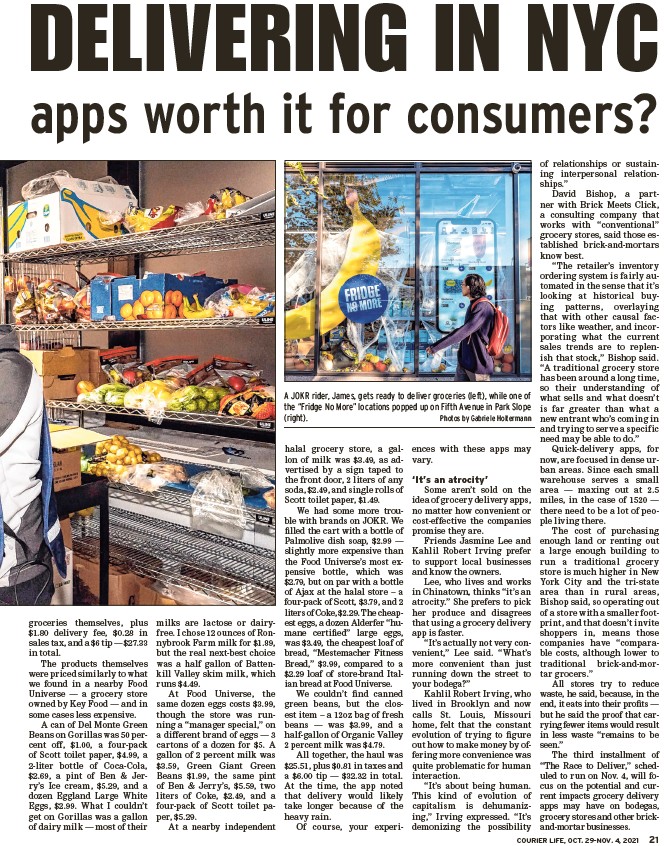
DELIVERING IN NYC
apps worth it for consumers?
COURIER LIFE, OCT. 29-NOV. 4, 2021 21
groceries themselves, plus
$1.80 delivery fee, $0.28 in
sales tax, and a $6 tip — $27.33
in total.
The products themselves
were priced similarly to what
we found in a nearby Food
Universe — a grocery store
owned by Key Food — and in
some cases less expensive.
A can of Del Monte Green
Beans on Gorillas was 50 percent
off, $1.00, a four-pack
of Scott toilet paper, $4.99, a
2-liter bottle of Coca-Cola,
$2.69, a pint of Ben & Jerry’s
Ice cream, $5.29, and a
dozen Eggland Large White
Eggs, $2.99. What I couldn’t
get on Gorillas was a gallon
of dairy milk — most of their
milks are lactose or dairyfree.
I chose 12 ounces of Ronnybrook
Farm milk for $1.89,
but the real next-best choice
was a half gallon of Battenkill
Valley skim milk, which
runs $4.49.
At Food Universe, the
same dozen eggs costs $3.99,
though the store was running
a “manager special,” on
a different brand of eggs — 3
cartons of a dozen for $5. A
gallon of 2 percent milk was
$3.59, Green Giant Green
Beans $1.99, the same pint
of Ben & Jerry’s, $5.59, two
liters of Coke, $2.49, and a
four-pack of Scott toilet paper,
$5.29.
At a nearby independent
halal grocery store, a gallon
of milk was $3.49, as advertised
by a sign taped to
the front door, 2 liters of any
soda, $2.49, and single rolls of
Scott toilet paper, $1.49.
We had some more trouble
with brands on JOKR. We
fi lled the cart with a bottle of
Palmolive dish soap, $2.99 —
slightly more expensive than
the Food Universe’s most expensive
bottle, which was
$2.79, but on par with a bottle
of Ajax at the halal store – a
four-pack of Scott, $3.79, and 2
liters of Coke, $2.29. The cheapest
eggs, a dozen Alderfer “humane
certifi ed” large eggs,
was $3.49, the cheapest loaf of
bread, “Mestemacher Fitness
Bread,” $3.99, compared to a
$2.29 loaf of store-brand Italian
bread at Food Universe.
We couldn’t fi nd canned
green beans, but the closest
item – a 12oz bag of fresh
beans — was $3.99, and a
half-gallon of Organic Valley
2 percent milk was $4.79.
All together, the haul was
$25.51, plus $0.81 in taxes and
a $6.00 tip — $32.32 in total.
At the time, the app noted
that delivery would likely
take longer because of the
heavy rain.
Of course, your experiences
with these apps may
vary.
‘It’s an atrocity’
Some aren’t sold on the
idea of grocery delivery apps,
no matter how convenient or
cost-effective the companies
promise they are.
Friends Jasmine Lee and
Kahlil Robert Irving prefer
to support local businesses
and know the owners.
Lee, who lives and works
in Chinatown, thinks “it’s an
atrocity.” She prefers to pick
her produce and disagrees
that using a grocery delivery
app is faster.
“It’s actually not very convenient,”
Lee said. “What’s
more convenient than just
running down the street to
your bodega?”
Kahlil Robert Irving, who
lived in Brooklyn and now
calls St. Louis, Missouri
home, felt that the constant
evolution of trying to fi gure
out how to make money by offering
more convenience was
quite problematic for human
interaction.
“It’s about being human.
This kind of evolution of
capitalism is dehumanizing,”
Irving expressed. “It’s
demonizing the possibility
of relationships or sustaining
interpersonal relationships.”
David Bishop, a partner
with Brick Meets Click,
a consulting company that
works with “conventional”
grocery stores, said those established
brick-and-mortars
know best.
“The retailer’s inventory
ordering system is fairly automated
in the sense that it’s
looking at historical buying
patterns, overlaying
that with other causal factors
like weather, and incorporating
what the current
sales trends are to replenish
that stock,” Bishop said.
“A traditional grocery store
has been around a long time,
so their understanding of
what sells and what doesn’t
is far greater than what a
new entrant who’s coming in
and trying to serve a specific
need may be able to do.”
Quick-delivery apps, for
now, are focused in dense urban
areas. Since each small
warehouse serves a small
area — maxing out at 2.5
miles, in the case of 1520 —
there need to be a lot of people
living there.
The cost of purchasing
enough land or renting out
a large enough building to
run a traditional grocery
store is much higher in New
York City and the tri-state
area than in rural areas,
Bishop said, so operating out
of a store with a smaller footprint,
and that doesn’t invite
shoppers in, means those
companies have “comparable
costs, although lower to
traditional brick-and-mortar
grocers.”
All stores try to reduce
waste, he said, because, in the
end, it eats into their profi ts —
but he said the proof that carrying
fewer items would result
in less waste “remains to be
seen.”
The third installment of
“The Race to Deliver,” scheduled
to run on Nov. 4, will focus
on the potential and current
impacts grocery delivery
apps may have on bodegas,
grocery stores and other brickand
mortar businesses.
A JOKR rider, James, gets ready to deliver groceries (left), while one of
the “Fridge No More” locations popped up on Fifth Avenue in Park Slope
(right). Photos by Gabriele Holtermann